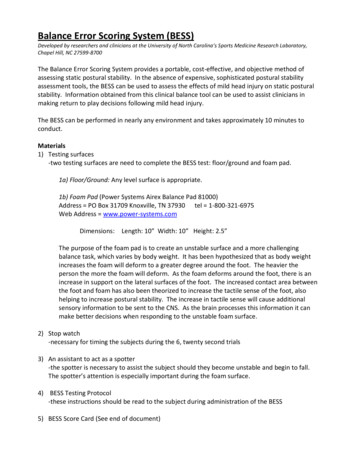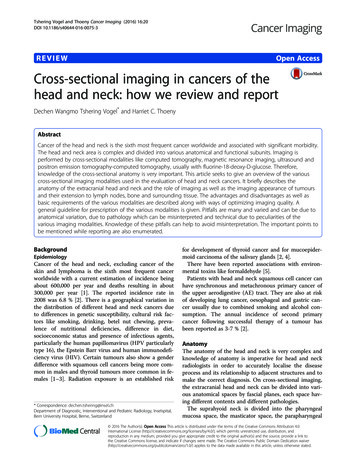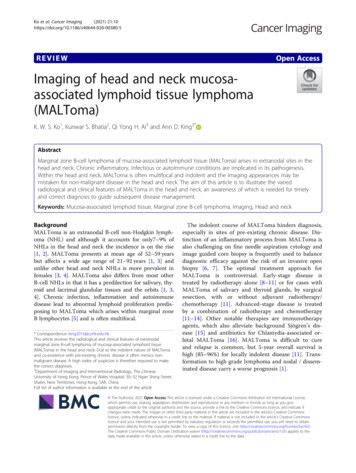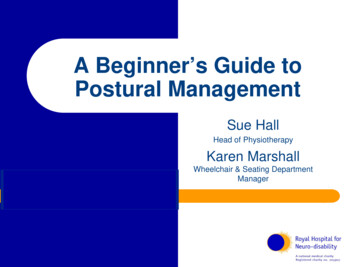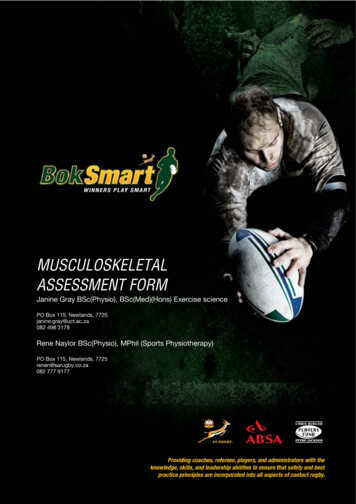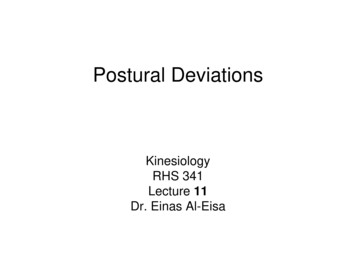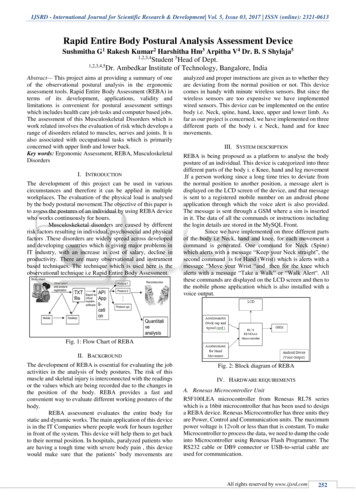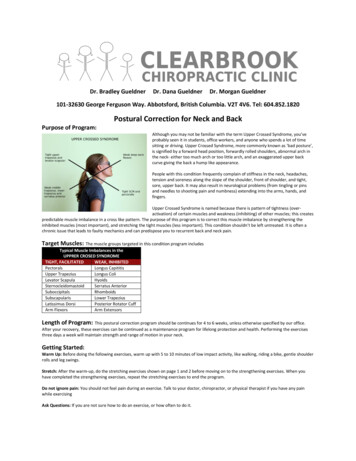
Transcription
Dr. Bradley GueldnerDr. Dana GueldnerDr. Morgan Gueldner101-32630 George Ferguson Way. Abbotsford, British Columbia. V2T 4V6. Tel: 604.852.1820Postural Correction for Neck and BackPurpose of Program:Although you may not be familiar with the term Upper Crossed Syndrome, you’veprobably seen it in students, office workers, and anyone who spends a lot of timesitting or driving. Upper Crossed Syndrome, more commonly known as ‘bad posture’,is signified by a forward head position, forwardly rolled shoulders, abnormal arch inthe neck- either too much arch or too little arch, and an exaggerated upper backcurve giving the back a hump like appearance.People with this condition frequently complain of stiffness in the neck, headaches,tension and soreness along the slope of the shoulder, front of shoulder, and tight,sore, upper back. It may also result in neurological problems (from tingling or pinsand needles to shooting pain and numbness) extending into the arms, hands, andfingers.Upper Crossed Syndrome is named because there is pattern of tightness (overactivation) of certain muscles and weakness (inhibiting) of other muscles; this createspredictable muscle imbalance in a cross like pattern. The purpose of this program is to correct this muscle imbalance by strengthening theinhibited muscles (most important), and stretching the tight muscles (less important). This condition shouldn’t be left untreated. It is often achronic issue that leads to faulty mechanics and can predispose you to recurrent back and neck pain.Target Muscles: The muscle groups targeted in this condition program includesTypical Muscle Imbalances in theUPPRER CROSED SYNDROMETIGHT, FACILITATEDWEAK, INHIBITEDPectoralsLongus CapititisUpper TrapeziusLongus ColiLevator ScapulaHyoidsSternocleidomastoidSerratus AnteriorSuboccipitalsRhomboidsSubscapularisLower TrapeziusLatissimus DorsiPosterior Rotator CuffArm FlexorsArm ExtensorsLength of Program: This postural correction program should be continues for 4 to 6 weeks, unless otherwise specified by our office.After your recovery, these exercises can be continued as a maintenance program for lifelong protection and health. Performing the exercisesthree days a week will maintain strength and range of motion in your neck.Getting Started:Warm Up: Before doing the following exercises, warm up with 5 to 10 minutes of low impact activity, like walking, riding a bike, gentle shoulderrolls and leg swings.Stretch: After the warm-up, do the stretching exercises shown on page 1 and 2 before moving on to the strengthening exercises. When youhave completed the strengthening exercises, repeat the stretching exercises to end the program.Do not ignore pain: You should not feel pain during an exercise. Talk to your doctor, chiropractor, or physical therapist if you have any painwhile exercisingAsk Questions: If you are not sure how to do an exercise, or how often to do it.
Postural Stretches:Child’s Pose StretchStart in a kneeling position.Drop your butt toward your heels as you stretch the rest of yourbody down and forward.You should feel a mild stretch in your shoulders andbuttocks and down the length of your spine and arms.Seated shoulder StretchIn the fully stretched position, rest your arms in a relaxed positionalong the floor, rest your stomach comfortably on top of yourthighs, and rest your forehead on the mat.Start seated, legs crossed. Place palms down, fingers backwardabout a foot off the hip. You can play with how it feels to pull thepalms off the floor and stretch the fingers long.Keep the arms straight and lean backward toward the floor.You should feel a mild stretch in front of yourshouldersNeck Stretch- TrapsTo maximize the stretch you really have to straighten the arms. Ifbending the arms cannot be avoided, move the hands furtherfrom the hips to increase the stretch.Start with your head neutral.Tucking your arm behind your back, to lock your shoulder in thedown position.Using the opposite hand, pull your head to the opposite side.You should feel a mild stretch on the side of your neckNeck Stretch- Levator ScapulaeStart with your head neutral.Tucking your arm behind your back, to lock your shoulder in thedown position. Holding the bottom of the chair also works.Using the opposite hand, pull your head so that your nose is closeto your arm pit. Repeat for the opposite side.You should feel a mild stretch between your neck andshoulder bladeTrunk StretchStart by clasping your hands above your head, head neutral.Gently move arms to the right side feeling the stretch turn onalong the left side of the trunk. Hold for 30 seconds. Repeat forthe opposite side.Relax the neck during this stretch.This stretch may be felt along the sides of your trunk,along the sides of your shoulder blades, through themid or low back
The door way pec stretch can be done in two ways, either:Door Way Shoulder StretchA)A) Both arms at the same time, or B) One arm at a time.Regardless of the option you choose, change the angle of yourarms, to facilitate a different stretch. Try below horizontal, athorizontal, and above horizontal. Changing the angle will stretchthe top, middle, and bottom of the pectoralis major muscle.Tip: Use your body weight to lean into the stretch for the doublearm version, or rotate your body away from the wall for the singlearm version.B)Straight arm- Targets Pec MajorBent arm- Targets Pec MinorYou should feel a mild stretch in front of yourshouldersBruegger’s Stretch/Desk Stretch:This is an excellent stretch for office workers. Start by moving yourbuttocks to the edge of your chair.Keep your feet shoulder width apart. Your knees and hips shouldbe at 90 degrees each.Arch your low back and stick your chest up. Tuck your chin and rollyour arms back and reach as far behind you as you can.Your thumbs should be pointing straight back and the top of yourhead should be pointing towards the ceiling. Hold for 20-30seconds.You should feel a mild stretch in front and top of yourshoulders
Postural Strengthening:Chin Tuck ExerciseOne of the most effective postural exercises for combating neckpain is the chin tuck exercise. This exercise not only helpsstrengthen the muscles that pull the head back into alignmentover the shoulders (upper thoracic extensors) but it alsostretches the scalene and suboccipital muscles.The chin tuck exercise can be done numerous times throughoutthe day, such as while sitting in the car or at the desk at work.The repetition of this exercise throughout the day also helpsdevelop good postural habits. It is especially important toperform this exercise when the neck and shoulder blades firstbegin to hurt.To perform the exercise for the first time it is oftenrecommended that patients stand with the spine up against asurface like a door jam or wall and the feet out about 3 inchesfrom the bottom.Keeping the spine against the surface, pull the upper back and head back until the back of the head touches. It is important tomake sure that the chin is down so that the head is pulled straight back and is not looking up.Hold the head back for 5 seconds. Repeat this ten times. After performing this exercise about ten times, start doing the exercisein standing or sitting without a door jamb or wall. The exercise can be done 5 to 7 times per day.TIP: Try doing these exercises at red lights, it can help you remember to do chin tucks daily and it’s no time wasted. When inthe car, use the headrest as a point to aim for when pulling the head back.Wall AngelsAnother important postural exercise is the wall angelexercise. This exercise is done standing with the back upagainst a large flat wall and the feet about 4 inches out fromthe bottom of the wall.Assume the same position as the chin tuck exercise with theback of the head against the wall.Bring your arms as far back to the wall as possible, so botharms are at a 90-degree angle.Lock the shoulder blades back and down (think of putting your shoulders in your back pocket). Slide arms over the head, whilenever allowing arms to lift off of the wall.Once overhead, bring your arms down so the elbows are flush against the side of your body, never allowing them to come off ofthe wall. Keep the shoulder blades squeezed back and down.The movement is slow and deliberate. Repeat this 10 times, 3 to 5 times per day.
Blackburn Exercises:These exercises are for training scapular retraction. They are among the most important exercises for conditioning the musclesbetween the shoulder blades to pull your shoulders back into ‘good’ posture. Make sure to avoid shrugging your shoulders (akalifting your shoulders towards your ears) while doing these exercises, we want to avoid activation of the upper fibers oftrapezius which contributes to postural imbalance.Perform 3 sets of 2 reps of each, 2 times a day. Use a table, bed, or exercise ball. As strength and endurance increases, add asmall 1 or 2lb weight to hands, progress to more weight (i.e 3-5lbs) if too easy.
Cable rowsSeated Cable Row: Use cable weight with V-bar attachment so palmsare facing each other. Start seated on a bench, with your armsextended, torso at a 90-deg angle to your legs, and your back slightlyarched with your chest sticking out. Keeping the torso stationary, pullthe handles back towards your torso while keeping the arms close toit until you touch the abdominals. Breathe out as you perform thatmovement. At that point you should be squeezing your back muscleshard. Hold that contraction for 1s and slowly go back to the originalposition while breathing in. Repeat for 12 reps, 3 sets.Cable Row to Face: Use a cable weight adjust it as high as possible. Tighten yourcore, raise your arms, draw your shoulders back, and pull the rope in towards yourmouth. Flare it and pull your rear deltoids as far back as possible. Like the previousexercise, squeezing your back muscles hard. Your elbows should stay highthroughout. Hold the contraction for 1s and slowly release it back to start. Repeatfor 12 reps, 3 sets.Tip: If these are too difficult start with a medium resistance therapeutic band wrapped around a door handle, then progress tothe normal cable rows.Arm ExtensorsExternal Rotators:
Postural Strengthening: Chin Tuck Exercise One of the most effective postural exercises for combating neck pain is the chin tuck exercise. This exercise not only helps strengthen the muscles that pull the head back into alignment over the shoulders (upper thoracic extensors) bu
